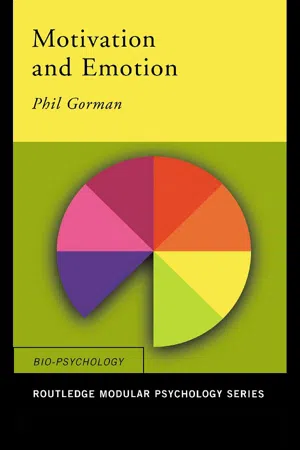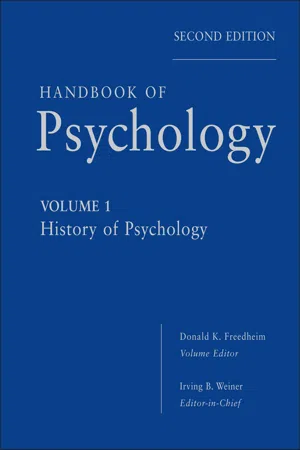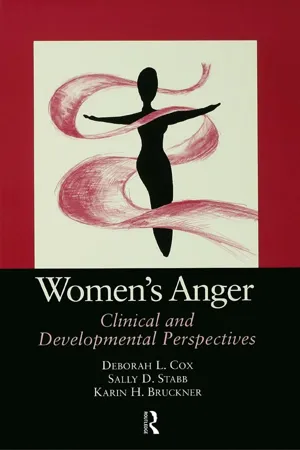Psychology
Theories of Emotion
Theories of emotion in psychology attempt to explain the underlying processes and factors that contribute to emotional experiences. Key theories include the James-Lange theory, which suggests that physiological responses precede emotions, and the Cannon-Bard theory, which proposes that physiological responses and emotions occur simultaneously. The Schachter-Singer two-factor theory emphasizes the role of cognitive appraisal in shaping emotional experiences.
Written by Perlego with AI-assistance
Related key terms
8 Key excerpts on "Theories of Emotion"
- eBook - ePub
- Melvin J. Lasky(Author)
- 2017(Publication Date)
- Routledge(Publisher)
emotion in the theories to be reviewed stresses the physiological and nonconscious mental features of emotion. It is necessary to begin with the James-Lange theory of the emotions, for here the physiological position is most forcefully and most clearly stated.The James-Lange Theory of Emotion
The James-Lange theory of emotion has been the subject of considerable scientific debate since its (1890) publication by William James in Principles of Psychology (see Wundt, 1891; Worcester, 1893; Dewey, 1894, 1895; Irons, 1894; Stratton, 1895; Baldwin, 1894; Mead, 1895, 1982a; Cannon, 1929; Sartre, 1939/1962; Schachter and Singer, 1962; Kemper, 1978b; Scheff, 1979, 1983). Portions of James’s theory were formulated by the Danish psychologist Carl Georg Lange in 1885, and James combined his views with those of Lange. The James-Lange theory offers a physiological accounting of the constitution, organization, and conditioning of the “coarser” emotions such as grief, fear, rage, and love, in which “everyone recognizes strong organic reverberations,” and the subtler “emotions, or those whose organic reverberations [are] less obvious and strong,” such as moral, intellectual, and esthetic feelings (James, 1890/1950, vol. 2, p. 449).The general causes of the emotions are assumed to be internal, physiological, nervous processes, not mental or psychological processes. Moods, affections, and emotions are “constituted and made up of those bodily changes which we ordinarily call their expression or consequence” (James, 1890/1950, vol. 2, p. 452). A purely disembodied emotion—for example, the emotion of fear without a quickened heartbeat, sharp breathing, or weakened limbs—would be a nonentity for this theory. The emotions are the result of bodily changes that occur as a reflex effect of an exciting object or fact confronted by the person. - eBook - ePub
- Philip Gorman(Author)
- 2004(Publication Date)
- Routledge(Publisher)
8 Explaining emotional behaviour and experience Theories Theories of Emotion Physiological theories Psychological theories Chapter summary Theories of Emotion The previous chapter considered the origins of emotion in relation to specific physiological functions and areas. In this chapter the various attempts to explain the origin, feeling and expression of emotions will be considered. The four components of emotions; feelings, bodily changes, environmental appraisal and behaviour, will be considered in this chapter, in relation to attempts by psychologists to organise them into a pattern of events that explains how they combine to form an emotion. Each of these theoretical attempts will provide its own version of the sequence of events involved in the emotional experience and how that is transformed into emotional behaviour. Most Theories of Emotion can be traced back to Darwin’s theory of evolution and the publication in 1872 of Darwin’s book The Expression of the Emotions in Man and Animals. According to this view, the expression of emotions has evolved as an adaptive function. Consider, for example, ritualised aggression: animals will benefit from having such clear displays of emotions as it will be clear to other members of their species what they are going to do next, e.g. a cat will arch its back when it is going to attack and will lower it to show submission - eBook - ePub
The Emotional Self
A Sociocultural Exploration
- Deborah Lupton(Author)
- 1998(Publication Date)
- SAGE Publications Ltd(Publisher)
Some theorists adopting this approach have attempted to systematize the emotions. Plutchik (1982), for instance, attempts what he terms a ‘psychoevolutionary structural’ theory of emotion. He defines an emotion as ‘an inferred complex sequence of reactions to a stimulus’, including ‘cognitive evaluations, subjective changes, autonomic and neural arousal, impulses to action, and behavior designed to have an effect upon the stimulus that initiated the complex sequence’ (1982: 551). Plutchik suggests that ‘there are eight basic adaptive reactions which are the prototypes, singly or in combination, of all emotions’, including incorporation (of food or new stimuli), rejection (the expelling of something seen to be harmful), protection, destruction, reproduction, reintegration (response to the loss of something deemed to be important), orientation and exploration. He argues that these are all adaptive behavioural patterns related to survival, and that there is a set of ‘primary’ emotions which correspond to these patterns: ecstasy, vigilance, adoration, terror, amazement, grief, loathing, rage, anger, annoyance, disgust, boredom, sadness, pensiveness, surprise, distraction, fear and apprehension.Appraisal and Emotion: Cognitive Theory
Cognitive Theories of Emotions, found mostly among social and behavioural psychologists and philosophers, are less biologically essentialist than several other ‘inherent’ approaches. While exponents of this approach maintain the conviction that there are some emotions that are universal to all humans, and that emotions have their basis in physiology, they have sought to identify the extent to which emotional behaviour is mediated through judgement and assessment of the context. From the cognitive approach it is argued that humans make judgements in relation to the physical sensations they feel when deciding what emotional state they are in. This approach builds on the writings of the early psychologist William James in his The Principles of Psychology, first published in 1890. James claimed that emotion begins with an initial bodily sensation (or set of sensations) in response to an event which is evaluated cognitively and labelled as a particular emotion: ‘we feel sorry because we cry, afraid because we tremble’ (James, quoted in Gergen, 1995: 8). From this perspective, therefore, the physical response is seen to precede the emotion and is interpreted in certain ways based on judgement of the situation. This is clearly a different approach from those perspectives I described above, which generally begin with the premise that emotion causes or is equivalent - eBook - ePub
- Paula M. Niedenthal, François Ric(Authors)
- 2017(Publication Date)
- Psychology Press(Publisher)
Variability in how emotion components fit together may be caused by stable individual differences. Some people may react to all emotional events primarily with facial expressions, whereas others may mostly show strong autonomic responses (Marwitz & Stemmler, 1998). There are individual differences in the complexity of cardiac responses across different experiences of stress that are provoked in the laboratory (Friedman, 2003). Psychological constructionists also suggest that the components of emotion are controlled by distinct neural and bodily systems that respond to particular features of the event in which an emotion was experienced (Russell, 2003; Stemmler, 2003). In their view, then, an emotion emerges from conceptualizations that trigger multiple response systems rather than one affect program.Figure 1.8 A schematic diagram of psychological constructionism.An emotion from the perspective of psychological constructionist theories is illustrated in Figure 1.8 . When events are encountered that have acquired emotional significance through learning, they cause a change in core affect. The changes are conceptualized in terms of emotion categories that are relevant to the current circumstances. The categorization may trigger some of the components of emotion, although they do not have to occur in one package. Components of emotion can be augmented or prevented due to social or cultural rules. The resulting responses constitute the total emotion.Summary
- Theories of Emotion are testable statements about 1) the causes of an emotion, 2) what people are born with (biological givens), and 3) how different components of emotion come together in the emotional expressions.
- Evolutionary Theories of Emotion hold that emotions are biologically evolved, functional responses to certain opportunities and challenges posed by the environment. One of the key predictions of the evolutionary theory of emotion, which we will revisit several times in this book, is that a set of universally recognized facial expressions of emotion exists.
- eBook - ePub
- (Author)
- 2012(Publication Date)
- Wiley(Publisher)
Frijda (1986) may be the most wide-ranging contemporary theorist. He starts off with a working definition that defines emotion as the occurrence of noninstrumental behavior, physiological changes, and evaluative experiences. In the process of trying a number of different proposals and investigating action, physiology, evaluation, and experience, Frijda arrives at a definition that's broad indeed. Central to his position are action tendencies and the individual's awareness of them. The tendencies are usually set in motion by a variety of mechanisms. Thus, Frijda (1986) describes emotion as a set of mechanisms that ensure the satisfaction of concerns, compare stimuli to preference states, and by turning them into rewards and punishments, generate pain and pleasure, dictate appropriate action, assume control for these actions and thereby interrupt ongoing activity, and provide resources for these actions (p. 473). The question is whether such mechanisms do not do too much and leave nothing in meaningful action that is not emotional. At least one would need to specify which of the behaviors and experiences that fall under such an umbrella are to be considered emotional and which not. But that would again raise the elusive problem as to what qualifies as an emotion.Ortony, Clore, and Collins (1988) define emotions as “valenced reactions to events, agents, or objects, with their particular nature being determined by the way in which the eliciting situation is construed” (p. 13). Such a definition is, of course subject to James's critique; it is abstracted from the “bodily felt” emotions. Richard Lazarus and his coworkers define emotion as organized reactions that consist of cognitive appraisals, action impulses, and patterned somatic reactions (Folkman & Lazarus, 1990; Lazarus, Kanner, & Folkman, 1980). Emotions are seen as the result of continuous appraisals and monitoring of the person's well-being. The result is a fluid change of emotional states indexed by cognitive, behavioral, and physiological symptoms. Central is the notion of cognitive appraisal, which leads to actions that cope with the situation. - eBook - ePub
Women's Anger
Clinical and Developmental Perspectives
- Deborah Cox, Sally Stabb, Karin Bruckner(Authors)
- 2016(Publication Date)
- Routledge(Publisher)
Emotions are short-lived, occur in complex contexts along with other psychological processes such as attention, appraisal, and social interaction, and must be measured against an ongoing stream of other autonomic nervous system (ANS) functioning. Izard (1993) believes that emotion is at least partially defined by physiological responses. In his theory of differential emotions, specific feelings each have a unique set of neural processes, which, regardless of whether or not they actually are expressed, always lead to a unique conscious experience. The subjective experience of emotion may or may not be articulated, but it is always felt. Izard states, “Thus emotion has three levels or aspects—neural, expressive, and experiential—and the term ‘emotion’ refers to all three components operating as an integral system” (p. 633). What are the differences between mood, personality, reflexes, and physiological arousal? Again, what exactly is anger? Can we say that someone, particularly, some woman, is just an angry person? If so, based upon what—her own report, her affective display, or her interactions with others? In most definitions, emotion is a very short-term phenomenon—moments, minutes, rarely longer. There is some debate about whether or not certain experiences that may be sustained over time, such as hope, for example, are “true” emotions. Usually, if an emotional experience persists over hours or days, it is then termed a mood. If moods become chronic or integrated into a person’s everyday way of being in the world over months or years, we choose to call them personality. As stated previously, some theorists see physiological arousal as a necessary prerequisite for emotion to occur. Some see physiological arousal as a concomitant response for many, but not all, kinds of emotion - eBook - ePub
The Emotions
A Philosophical Introduction
- Julien Deonna, Fabrice Teroni(Authors)
- 2012(Publication Date)
- Routledge(Publisher)
6 Perceptual theories of the emotions
While accounting for some important aspects of the emotions, the various theories we have considered up to now face serious difficulties, which essentially have to do with the fact that they remain almost completely silent on the nature of the felt aspect of emotions. After all, one of the most surprising aspects of the evaluative judgment theory discussed in the last chapter consists in its failure to come to grips with the fact that emotions are experiences, and as such cannot be assimilated to judgments. We have thus repeatedly underlined the importance of the felt aspect of emotions and have spoken of phenomenology, qualitative experience, hedonic quality, and feeling, while leaving open the question of the relation between emotion and feeling.The purpose of this chapter is then to gain a better grasp of the role feelings play in an analysis of emotions and to specify their nature. The starting point for our discussion will be the theory put forward by William James, a theory that identifies emotions with distinctive kinds of feelings. We shall see that this theory proves unsatisfactory, precisely because it fails to account for the intimate links between emotions and evaluative properties. This will then lead us to consider and criticize two contemporary approaches to the emotions – conceptions according to which emotions are direct or indirect perceptions of evaluative properties – that emphasize both their phenomenological aspects and their intentional relations to evaluative properties.James's theory
As we pointed out at the very beginning of this book, it is striking how ordinary language constantly brings to the foreground the bodily dimension of emotions. When Jonas is afraid, he feels his heart racing, his breathing quicken, his throat constrict, and so on. When Mary is ashamed, she feels the blood go to her head, her knees go weak, her shoulders fall, and so on. So why not appeal directly to these features in analyzing emotions? Descartes, for one, held that a passion is the consciousness of the activity of animal spirits in the body. This kind of view is today more commonly associated with the names of William James (1884, 1890/1950: Chapter 25) and Carl Lange (1922). - eBook - ePub
- John DeLamater, Jessica Collett(Authors)
- 2018(Publication Date)
- Routledge(Publisher)
These emotional states last even after physical arousal has passed (Gordon, 1990). Each is a pattern of sensations, emotions, actions, and cultural beliefs that are appropriate to a social relationship. Peggy Thoits’s (1989) four-factor model described in the beginning of this chapter expanded Schachter’s two-factor theory. In her model, in addition to situational cues and a physiological response, to experience an emotion there must also be emotional expression and a label for the particular emotion. In other words, in Thoits’s model someone’s heightened heart rate (physiological response) at the sight of a bear (situational cues) is recognized as fear (label for the emotion) and their raised brow, wide eyes, and scream (expressions of fear) demonstrate that fear to themself and others. The Importance of Others in Emotional Experiences. At times, it is people in our social circles who define our emotions for us. Like us, they consider physiological reactions, social contexts, and our behavior to determine how we might be feeling and then communicate this to us. On the first day of kindergarten, a young child might describe to their father that they feel strange. When he asks them what they mean by strange, they would try to describe their physical symptoms or emotions but may not have acquired the cognitive or linguistic skills to say “light-headed” or “anxious” or even to interpret the physio logical arousal as an indicator of an emotional state. If they describe the feeling as a bee buzzing through their body, from up in their head to down in their stomach, their father would likely explain to them that they are feeling excited or nervous and that such an emotion is completely normal in a new situation
Learn about this page
Index pages curate the most relevant extracts from our library of academic textbooks. They’ve been created using an in-house natural language model (NLM), each adding context and meaning to key research topics.







